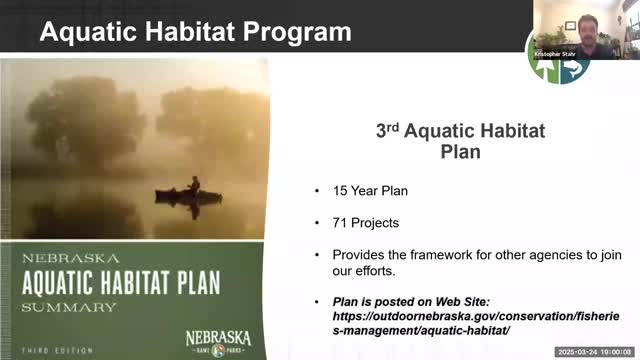State implements aggressive measures to control aquatic invasive species growth
January 01, 2025 | Nebraska Game and Parks Commission (NGPC), State Agencies, Organizations, Executive, Nebraska
This article was created by AI summarizing key points discussed. AI makes mistakes, so for full details and context, please refer to the video of the full meeting. Please report any errors so we can fix them. Report an error »

The Nebraska Statewide/Aquatic Habitat Plan Meeting convened on January 1, 2025, to address critical issues surrounding aquatic management and habitat preservation in the state. The meeting featured discussions on invasive species management, particularly focusing on zebra mussels and various aquatic vegetation, as well as trout growth rates in hatcheries.
The session began with a presentation highlighting the proactive measures needed to prevent the spread of zebra mussels, which currently have not proliferated across Nebraska. Participants emphasized the importance of public engagement in maintaining vigilance against these invasive species. Chris, a key speaker, elaborated on the "clean, drain, and dry" initiative aimed at preventing the introduction of invasive species into local water bodies.
The conversation then shifted to the management of invasive aquatic vegetation, which poses a significant threat to Nebraska's ecosystems. Chris noted the alarming spread of species such as Eurasian watermilfoil and curly leaf pondweed, which can choke waterways and disrupt native fish and plant populations. Over the past five years, over a hundred water bodies have been sampled to monitor these invasive plants, allowing for early intervention with aquatic herbicides. With new funding secured, the state plans to intensify its efforts in controlling these invasive species, including a recent successful treatment at North Platte I-80 Lake.
The meeting also included insights from Matthew Perion, the assistant administrator for fish hatcheries. He discussed the growth rates of trout in hatcheries, explaining that advancements in feed conversion have allowed for more efficient growth. By optimizing feeding practices and extending the time trout spend in hatcheries, the state aims to stock larger fish, enhancing recreational fishing opportunities.
In conclusion, the Nebraska Statewide/Aquatic Habitat Plan Meeting underscored the ongoing challenges posed by invasive species and the state's commitment to proactive management strategies. The discussions highlighted the importance of public involvement and scientific intervention in preserving Nebraska's aquatic habitats for future generations.
The session began with a presentation highlighting the proactive measures needed to prevent the spread of zebra mussels, which currently have not proliferated across Nebraska. Participants emphasized the importance of public engagement in maintaining vigilance against these invasive species. Chris, a key speaker, elaborated on the "clean, drain, and dry" initiative aimed at preventing the introduction of invasive species into local water bodies.
The conversation then shifted to the management of invasive aquatic vegetation, which poses a significant threat to Nebraska's ecosystems. Chris noted the alarming spread of species such as Eurasian watermilfoil and curly leaf pondweed, which can choke waterways and disrupt native fish and plant populations. Over the past five years, over a hundred water bodies have been sampled to monitor these invasive plants, allowing for early intervention with aquatic herbicides. With new funding secured, the state plans to intensify its efforts in controlling these invasive species, including a recent successful treatment at North Platte I-80 Lake.
The meeting also included insights from Matthew Perion, the assistant administrator for fish hatcheries. He discussed the growth rates of trout in hatcheries, explaining that advancements in feed conversion have allowed for more efficient growth. By optimizing feeding practices and extending the time trout spend in hatcheries, the state aims to stock larger fish, enhancing recreational fishing opportunities.
In conclusion, the Nebraska Statewide/Aquatic Habitat Plan Meeting underscored the ongoing challenges posed by invasive species and the state's commitment to proactive management strategies. The discussions highlighted the importance of public involvement and scientific intervention in preserving Nebraska's aquatic habitats for future generations.
View full meeting
This article is based on a recent meeting—watch the full video and explore the complete transcript for deeper insights into the discussion.
View full meeting
